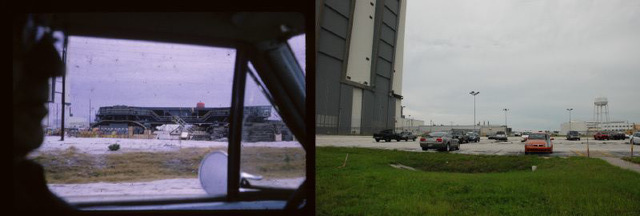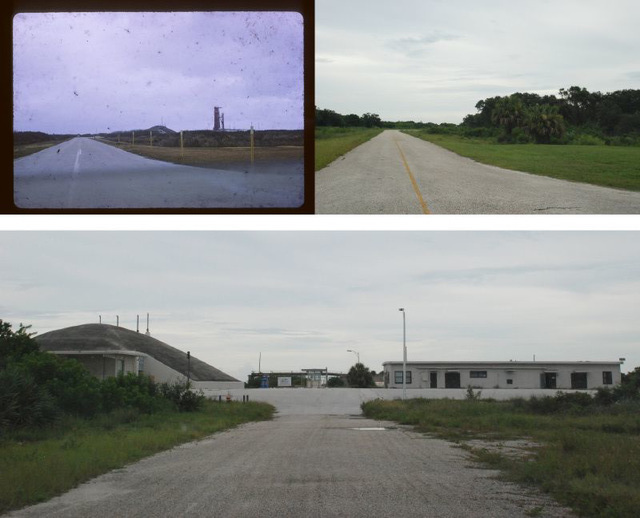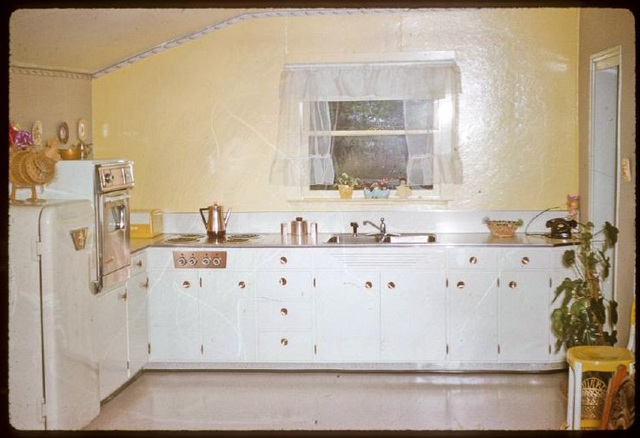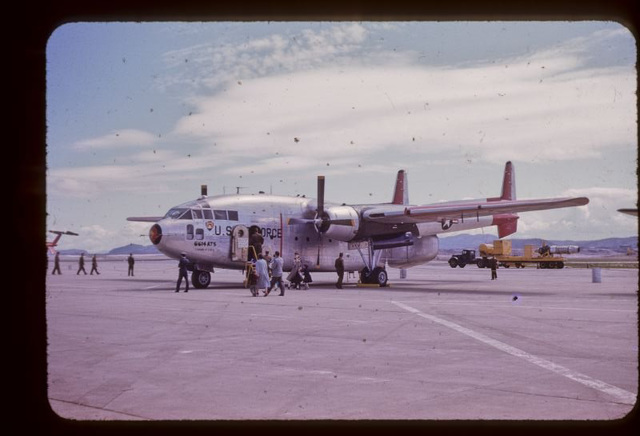
Slide Scans
Scans from the old family slide collection, done (like the other film scans here) using a Nikon Super Coolscan 5000.
27 Sep 2007
Shop Aid
Since Nikon doesn't provide any accessories for the Super Coolscan 5000 ED with which to scan 110 film (for reasons now obvious to me -- the film sucks), I made myself a film carrier for the negatives.
It consists of four layers of bristol paper (heavy white art paper), 5cm x 5cm, taped together along the edges. I cut a 19mm x 14mm hole in the middle, and then made small slits between the inner two layers of paper through which to slide the negative. The whole thing is a bit more square than it appears in this picture.
It's a little tricky to get the prepped negative into the scanner without bumping the negative out of position, but it can be done with a steady hand and foreceps.
14 Aug 2009
Compare: VAB crawlerway, 1965 and 2009
The image on the left is scanned from a slide my grandparents shot while driving around Cape Canaveral/Kennedy Space Center in early 1965. The picture on the right was taken on August 7, 2009 from roughly the same location (perhaps a little closer in).
Note that in the picture on the left, the apparently still-under-construction crawler is parked on the crawlerway, in front of the two VAB highbays used for storage and the hurricane safe haven today. Out of frame to the right of the "today" picture are OPF 1 and 2, the conjoined building where Orbiters are refurbished between flights.
14 Aug 2009
Compare: VAB, 1965 and 2009
The image on the left is scanned from a slide my grandparents shot while driving around Cape Canaveral/Kennedy Space Center in early 1965. The picture on the right was taken on August 7, 2009 from roughly the same location (about 10 yards back), showing the area as it looks today (the wider angle of the photo on the right is indicated by the desaturated area).
04 Sep 2009
Mercury Monument, Then and Now
The image on the left is from a slide taken by my grandparents in early 1965, the one on the left I took in August 2009, showing the same scene today.
Unfortunately, the printed image I was using as a reference was not complete, cutting off at the corner of the pedestal. It was also nearly impossible with my D-80 to get the perspective to match the original image, even while crouching down to simulate an old slide camera held at chest height (judging by the crossbar on the monument, I obviously didn't crouch down enough).
The people in the photo are other tourists, no connection to my grandparents (ie: I don't know who they are).
04 Sep 2009
LC-17, Then and Now
On the left, an old slide taken by my grandparents in early 1965. On the right, the same area today, if not quite the same view.
I'm still not convinced that the slide isn't backwards and taken from the coastal side of the towers. The orientation guide here was the equipment on the top of the towers, which is shaped vaguely like a slipper, and is plainly visible in both shots - the problem was, the new shots taken from the coastal side of the towers match up even less well.
04 Sep 2009
LC-34, Then and Now
On the left, a slide taken by my grandparents in early 1965, on the right the same view in August 2009.
In the old image, the mobile service structure for LC-34 is visible in the distance, along with the umbilical tower at one of the LC-37 pads (the skinny reddish mast at the far left of the old image).
Interestingly, in the original versions of both pictures, I can tell that the second sign along the road is the same in both pictures, the first sign (with the words "Road Block" on it) might be the same but it's hard to tell, and the flame deflectors are visible in the same parked positions. Even the notch in the edge of the pavement at the corner is the same, and some of the telephone poles may even be originals.
What's odd is the sense of depth between the two pictures. There's no mistaking they show the same scene, but the pad looks significantly closer to the camera in my shot than in the old slide - and this is the case for several of these comparisons.
Unlike the other comparisons, the slide image is cropped square - this was because the original was rotated by about 3 degrees, which was enough to obscure some of the similarities at first glance.
04 Sep 2009
LC-14, Then and Now
The top left image is from a slide taken by my grandparents in early 1965. The upper right image is the same view from August 2009.
The lower image is what is left of the launch facility, hidden now by the foliage on the righthand side of the access road -- the mound on the left is the launch control blockhouse, and straight ahead is the rocket launch mount and the foundation for the red launch umbilical tower seen in the older image. The tower itself is I think the one shown in other images in my KSC tour set, laid out in segments in a parking lot at the nearby rocket park.
13 Dec 2009
Dream Kitchen, Circa 1955
Note the stainless steel and copper appliances and fixtures - very trendy. I rented a house in college with nearly identical cabinets and a black linoleum countertop.
(From one of my uncle's slides.)
13 Dec 2009
Fly the Friendly Skies
A military transport plane, from one of my uncle's slides from the 1950s. Note the family in civilian attire approaching the nose of the plane, and the jet engine on the yellow test rig in the background.
The plane appears to be a Fairchild C-119 Flying Boxcar. The nose marking on the plane reads "6614 ATS", the number on the nosewheel door is "8048" (possibly identifying it as number 51-8048). This census site doesn't include a plane with "8048" as a number, so it's not one of the surviving copies apparently.
If you look carefully, it appears that the plane has its tail doors open.
Jump to top
RSS feed- Latest items - Subscribe to the latest items added to this album
- ipernity © 2007-2024
- Help & Contact
|
Club news
|
About ipernity
|
History |
ipernity Club & Prices |
Guide of good conduct
Donate | Group guidelines | Privacy policy | Terms of use | Statutes | In memoria -
Facebook
Twitter










